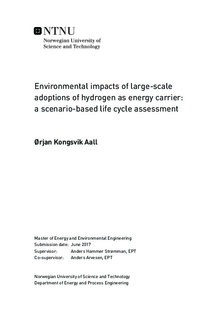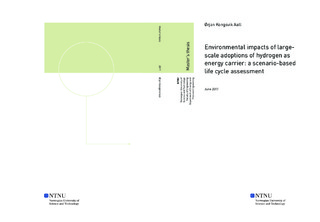| dc.description.abstract | The world is facing a severe threat in terms of climate change, and the use of fossil fuels for transport and electricity production is a major contributor. The use of hydrogen is foreseen to reduce greenhouse gas (GHG) emissions from transport by means of using hydrogen in fuel cell vehicles as well as increase energy security in electricity production by means of using hydrogen as temporary storage of energy.
In this thesis I have calculated the GHG emissions for several promising hydrogen production methods for today and the potential reduction towards 2050 through life cycle assessment. Then, I have estimated a technical potential for hydrogen production in 2050, based on available biomass in form of waste, short rotational crops and residues from agriculture, forestry and farming. Last, I put together a life cycle assessment of the hydrogen semi-truck Nikola One, to found the basis of a scenario assessment of using hydrogen as fuel for road freight transport in Europe towards 2050.
The initial life cycle assessment, calculated per kg hydrogen, showed a large variation for the following hydrogen production methods: biogas steam reforming (3.9kg CO2-eq), gasification (10.8 kg CO2-eq), dark fermentation together with photo fermentation (8 kg CO2-eq), dark fermentation together with microbial electrolysis cell (13.2 kg CO2-eq) and a proton exchange membrane water electrolyzer (40 kg CO2-eq). For the proton exchange membrane water electrolyzer (PEMWE), 85% of the emissions was due to the use of electricity, assumed to be from the European electricity mix. For the rest, that are based on biomass, their emissions originates on average 25% from the use of short rotational woody crops, and forestry residues as biomass feedstock, 29% from the use of fossil gas as energy source for heat and steam, and 38% from the use of electricity.
To assess the potential emission reduction towards 2050 I assumed that the production methods that uses fossil gas for heating will convert to using biomass instead. I also assume, based on EUs Reference Scenario for 2050, that the emission per kWh for the European energy mix reduces with 37%. Per kg hydrogen produced the results are: biogas steam reforming (2.8kg CO2-eq), gasification (3.7 kg CO2-eq), dark fermentation together with photo fermentation (5.5 kg CO2-eq), dark fermentation together with microbial electrolysis cell (8.9 kg CO2-eq) and a proton exchange membrane water electrolyzer (27 kg CO2-eq).
To calculate the total hydrogen production capacity for Europe in 2050 I assume that it mainly will consist of hydrogen from biomass due to the low GHG emissions. In addition, I assume that water electrolysis uses 1% of available electricity from solar, wind, and hydropower to produce hydrogen to secure the system, so that it is possible to have a complete hydrogen fueling system for transport. Calculations shown that by using all the technical biomass capacity in form of waste, short rotational crops and residues from agriculture, forestry and farming a total of 92.9 megatons of hydrogen can be produced per year, given the use of biogas steam reforming, gasification and dark fermentation together with photo fermentation. The total yearly hydrogen production from water electrolysis is estimated to be 0.3 megatons. The resulting European average GHG emission per kg hydrogen is 4 kg CO2-eq.
An estimate of the total fuel consumption for road freight transport in 2050, given a full transition over to hydrogen, show that it is needed 21 megatons of hydrogen, which is 23% of the estimated potential yearly production of 2050. To assess the potential GHG mitigation potential for a freight transport fleet fueled on hydrogen I have conducted a life cycle assessment of the hydrogen truck Nikola One. The results, given an emission of 4 kg CO2-eq per kg H2, show that there is a emission reduction potential of 45%, compared to today, and a emission reduction potential of 54%, compared to a scenario for 2050 with only use of fossil fuels.
My results show that here is a potential for large-scale hydrogen production from biomass in Europe towards 2050, and that it can supply fuel for the entire road freight transport fleet. The GHG emissions are nevertheless dependent both on the different production methods, the use of fossil gas and the electricity mix. Hydrogen from water electrolysis is especially sensitive to emissions from the energy mix, and should only be used directly together with renewable energy. | |

